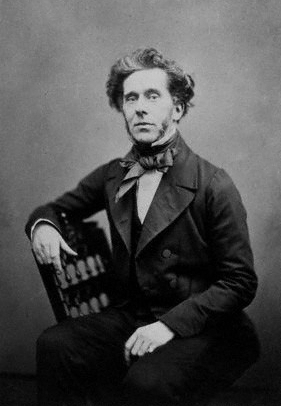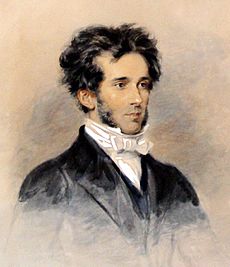Theophilus Thompson (physician) facts for kids
Quick facts for kids
Theophilus Thompson
|
|
|---|---|

portrait taken in 1855
|
|
| Born | 20 September 1807 Islington, London, England
|
| Died | 11 August 1860 (aged 52) Sutton, Surrey, England
|
| Occupation | Physician |
| Years active | 1830 - 1860 |
| Known for | work on influenza, tuberculosis Fellow of Royal Society |
Theophilus Thompson (1807–1860) was an important doctor in London during the Victorian era. He was well-known for his studies and writings about diseases like tuberculosis (a serious lung infection) and influenza (the flu).
Contents
Meet Theophilus Thompson
His Early Life and Education
Theophilus Thompson was born on September 20, 1807, in Islington, London. His father, Nathaniel Thompson, was a textile merchant. Theophilus grew up in a religious family. After his mother passed away when he was young, his older brother, Thomas Thompson, helped look after him. Thomas was known for supporting religious causes.
Theophilus studied medicine at St. Bartholomew's Hospital in London. Then, in 1830, he earned his M.D. degree from the University of Edinburgh in Scotland. He also traveled to Paris, France, to learn from famous French doctors like Gabriel Andral and Guillaume Dupuytren. He even attended lectures about animals from zoologist Isidore Geoffroy Saint-Hilaire.
His Medical Career
After finishing his studies, Theophilus Thompson started his own medical practice in London. Soon, he became a doctor at the St. Pancras Northern Dispensary in Middlesex, London, where he worked for 14 years. He also taught medicine at the Grosvenor Place School of Medicine.
In 1846, he was chosen to be a Fellow of the Royal Society. This is a very respected group for scientists. In 1847, he became a doctor at the Hospital for Consumption and Diseases of the Chest. This hospital later became the famous Royal Brompton Hospital.
Theophilus Thompson was also a leader in medical groups. He was president of the Medical Society of London in 1844. He also led the Harveian Society of London.
He is remembered for bringing new ideas to medicine in England. He was one of the first to use cod-liver oil to help patients. He also used bismuth to treat diarrhea in people with tuberculosis. He was the first to give oxide of zinc for night sweats. He was also one of the first British doctors to use the stethoscope, a tool to listen to heart and lung sounds. He learned how to use it during his studies in Paris.
His Family Life
Theophilus Thompson married Elizabeth Anna Maria Wathen in 1831. They had five children together:
- Theophilus Wathen Thompson (1832–1905) became a lawyer.
- Elizabeth Gertrude Thompson (1833–1904) married a church minister.
- Arthur Steinkopff Thompson (1835–1919) also became a church minister.
- Edmund Symes-Thompson (1837–1906) followed in his father's footsteps. He became a doctor at the Royal Brompton Hospital. He also updated his father's important paper about flu epidemics.
- Constance Mary Thompson (1841–1924) married a church minister.
His Passing
Theophilus Thompson passed away on August 11, 1860, at the age of 52. He died from bronchitis in Sutton, Surrey. He is buried in Norwood Cemetery in London. There are several portraits of him, including a watercolor painting and a photograph at the National Portrait Gallery in London.
Images for kids




